How Local Health Districts can prepare for the effects of climate change: an adaptation model applied to metropolitan Sydney
Lucie Rychetnik A B E , Peter Sainsbury B C and Greg Stewart DA School of Medicine Sydney, University of Notre Dame Australia.
B School of Public Health, University of Sydney.
C Population Health, South Western Sydney Local Health District. Email: petersainsbury27@gmail.com
D Primary Integrated and Community Health, South Eastern Sydney Local Health District. Email: Greg.Stewart@health.nsw.gov.au
E Corresponding author. Email: lucie.rychetnik@nd.edu.au
Australian Health Review 43(6) 601-610 https://doi.org/10.1071/AH18153
Submitted: 24 July 2018 Accepted: 29 September 2018 Published: 21 December 2018
Journal Compilation © AHHA 2019 Open Access CC BY-NC-ND
Abstract
Climate change adaptation can be defined as a form of risk management (i.e. assessing climate change-related risks and responding appropriately so that the risks can be pre-emptively minimised and managed as they arise). Adapting to climate change by hospital and community health services will entail responding to changing health needs of the local population, and to the likely effects of climate change on health service resources, workforce and infrastructure. In this paper we apply a model that health services can use to predict and respond to climate change risks and illustrate this with reference to Sydney’s Local Health Districts (LHDs). We outline the climate change predictions for the Sydney metropolitan area, discuss the resulting vulnerabilities for LHDs and consider the potential of LHDs to respond. Three ‘core business’ categories are examined: (1) ambulance, emergency and acute health care; (2) routine health care; and (3) population and preventative health services. We consider the key climate change risks and vulnerabilities of the LHDs’ workforce, facilities and finances, and some important transboundary issues. Many Australian health services have existing robust disaster plans and management networks. These could be expanded to incorporate local climate and health adaptation plans.
What is known about the topic? There is an inextricable relationship between climate change and human health, with important implications for the delivery of health services. Climate change will affect health service demand, and the resources, workforce and infrastructure of health services.
What does this paper add? This paper outlines how local health services can use existing data sources and models for assessing their climate change-related risks and vulnerabilities to predict, prepare for and respond to those risks. This is illustrated with reference to Sydney’s LHDs.
What are the implications for practitioners? Adaptation to climate change by health services is an important component of risk management. Local health services need to prepare for the effects of climate change by assessing the risks and developing and implementing climate and health adaptation plans.
Additional keywords: health services, health systems, population health, risk management.
Introduction
There is an inextricable relationship between climate change and human health.1,2 In many parts of the world, the changing climate is already having major health and social effects due to weather extremes, reduced food and water security and the spread of infectious disease.3,4 As a result, leading international agencies and Australian health organisations have prioritised action on climate change, including the growing need and importance of adaptation by local health services.5–8 In Australia, the Climate and Health Alliance (CAHA) has led the development of a framework for a national strategy on climate, health and well-being that outlined seven areas requiring government policy action, including emergency and disaster preparedness and building a climate-resilient health sector.8 The national framework has also been referenced in a recent Senate Select Committee report on the implications of climate change on Australia’s national security.9
Thus, climate change adaptation can be defined as a form of risk management (i.e. assessing climate change-related risks and responding appropriately so that they can be managed as they arise).10,11 The UKCIP (formerly known as the UK Climate Impacts Program) at the University of Oxford offers online risk-based adaptation resources to assist organisations with local climate change adaptation planning.10 Steps include assessment of current and future climate vulnerabilities and development and evaluation of agency-appropriate adaptation measures.10 The US Centres for Disease Control have developed a similar framework for Building Resilience against Climate Effects (BRACE) by public health agencies.11 Adapting to climate change by hospital and community health services would entail identifying effects on a population’s health and its use of health services, as well as preparing for the effects of climate change on health service resources, workforce and infrastructure. In this paper we illustrate how the existing models and available data can be used by local health services to predict the local risks and prepare for the effects. To do this, we outline the climate change predictions for the Sydney metropolitan area, present the health service problems and vulnerabilities for the Local Health Districts (LHDs) and consider the potential of LHDs to respond. As recommended by existing frameworks,10,11 subsequent steps would entail the New South Wales (NSW) health service and its LHDs developing and implementing their own climate and health adaptation plans, possibly within the existing disaster management frameworks.
Sydney’s observed and projected climate change
Although average Sydney temperatures fluctuate from year to year, overall over the past two decades the winter warm spells have been generally lasting longer, occurring more often and becoming more intense.12 Sydney summers are also getting hotter, with more frequent and intense extremes. For example, during the summer of 2016–17, Sydney had a record total numbers of days at 35°C or above, and January 2017 was the warmest month on record. Since the late 1950s, Sydney has also experienced progressively longer heatwaves (Fig. 1; see also Box 1). In the summer of 2016–17, Sydney had the second highest total number of ‘3-day heatwave’ days, and its highest number of heatwave days in the extreme category. Even between heatwaves, the summer of 2016–17 was notable for its almost continuously above-average temperatures.12
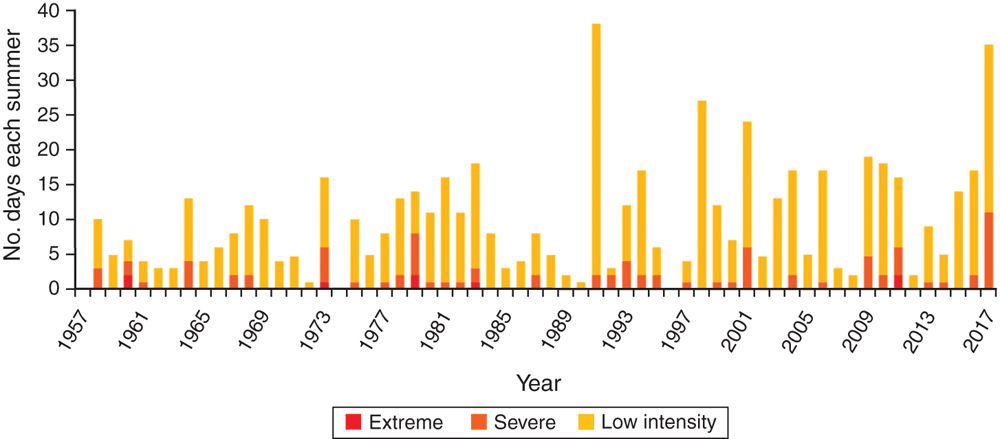
|
| Box 1. Bureau of Meteorology heatwave definitions and categories From http://media.bom.gov.au/social/blog/891/how-will-i-know-if-a-heatwave-is-coming/ [verified 17 April 2018] |
| The Bureau defines a heatwave as three or more days in a row when both daytime and night-time temperatures are unusually high in relation to the local long-term climate and the recent past. These are categorised as follows: |
|
Sydney’s current climate is summarised in Box 2.
| Box 2. Sydney’s current climate |
| Sydney’s climate is humid subtropical and areas closer to the ocean have average temperatures ranging from approximately 15°C in winter to approximately 25°C in summer. However, like the rest of Australia, Sydney’s weather can vary significantly and is highly influenced by the El Niño Southern Oscillation (ENSO). The negative phase of El Niño tends to bring below-average rainfall and warmer temperatures, whereas La Niña is associated with above-average rainfall and cooler temperatures.15 |
| Sydney’s average annual rainfall is 1200 mm, but this varies highly throughout the year. February is usually the wettest and winter is significantly drier. Sydney is also prone to severe storms, including approximately 20 thunderstorms per year. Storms often arise due to east coast lows (ECLs), which can occur at any time. ECLs tend to bring heavy rain, strong gusty winds and high seas, and cause significant damage to buildings and power lines, particularly from fallen trees, as well as localised flash flooding.16 |
Future climate change projections for different Australian regions have been prepared by the CSIRO and Bureau of Meteorology.13 The relevant projections for the East Coast Cluster – South (including the Sydney region) are compiled in Table 1.
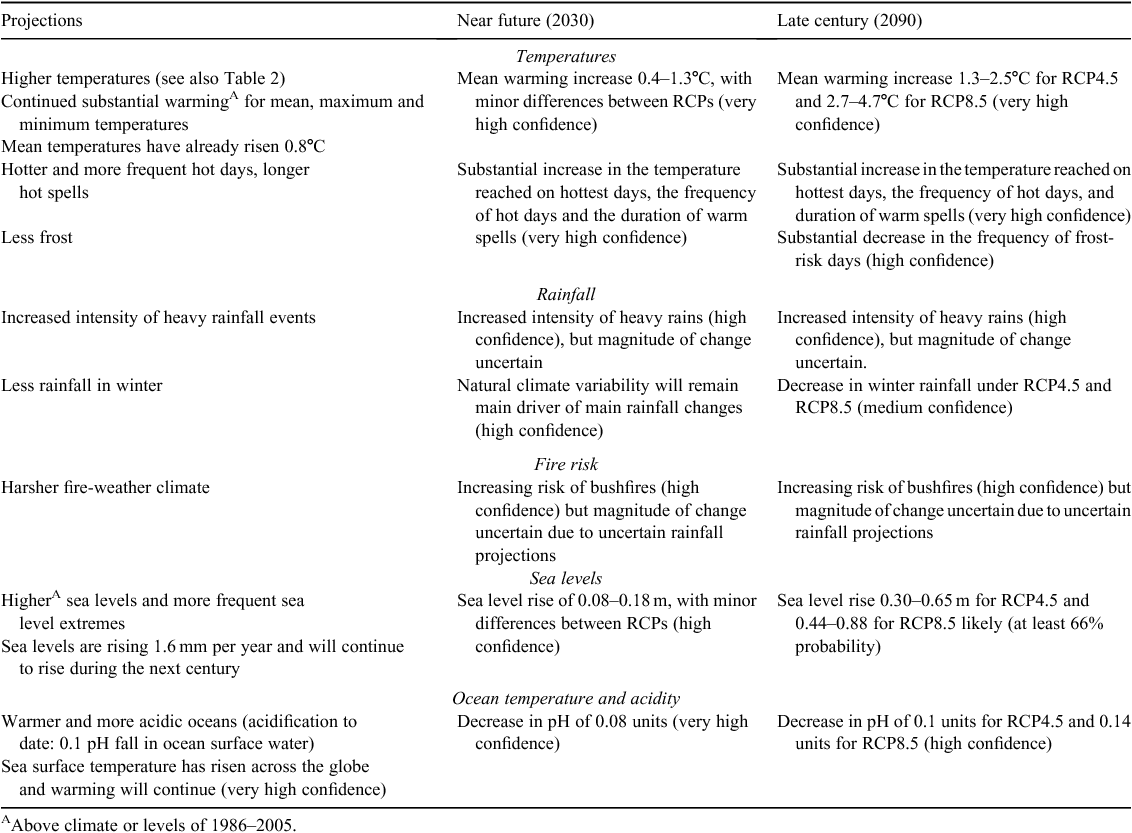
|
In summary, Sydney’s average temperatures will continue to increase in all seasons. There will be more very hot days, more frequent and longer warm spells and progressively harsher fire weather. The intensity of extreme rainfall will increase, and there will be some longer-term decreases in winter rain. Mean sea levels and the height of extreme sea levels will continue to rise. However, natural variabilities may mask or enhance longer-term anthropogenic changes over the next 20 years, particularly for rainfall.13
A projected increase in the average number of days above 35°C and 40°C is summarised in Table 2 (2030 and 2090 compared with the average for 1981–2010).13 It is of note that the projected increase in the frequency and severity of extreme heat outlined in Table 2 appears conservative relative to the observed more recent heatwaves reported in Fig. 1. Indeed, other modelling from the NSW and Australian Capital Territory (ACT) Regional Climate Modelling (NARCliM) project, which provides data specific to the Sydney metropolitan area, suggests a greater increase in heat extremes.14 The current annual number of hot days (above 35°C) of less than 10 days per year near the coast and 10–20 days per year in the western suburbs is projected to increase by approximately 4 days by 2030 and by approximately 11 days by 2070. This is summarised in Fig. 2. Recent modelling by researchers at the Australian National University also suggests that Sydney may experience summer extremes as high as 50°C as early as 2040, even under scenarios where global average temperature increases are contained to 2°C.17

|
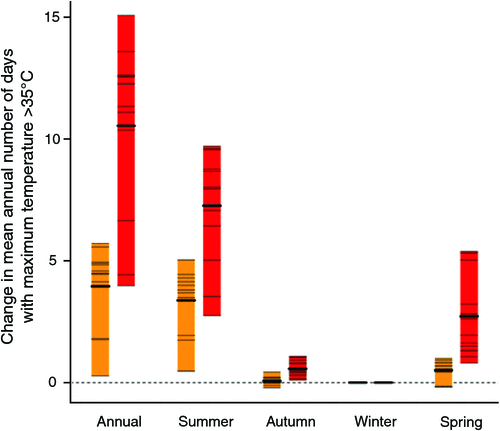
|
Vulnerabilities for Sydney LHDs arising from climate change
The direct and indirect health effects of climate change have been well described, both globally and for Australia1,8,18–20 (Appendix 1). The measurement and quantification of health effects will enable us to monitor the effectiveness of adaptation and mitigation strategies.3,4,21,22 In Australia, the single most dangerous climate-related hazard is extreme heat, which has been responsible for 4555 fatalities nationwide (since 1900), more than from all other natural hazards combined.23 Heat stress and heat exhaustion also affect morbidity (with children, elderly people, pregnant women and people with pre-existing conditions and disabilities most at risk) and severely affect work capacity.24,25
As demonstrated in Fig. 1, heatwaves are a significant concern for metropolitan Sydney, and thus its LHDs. For planning climate change adaptation, it can be useful to consider former climate- and/or weather extreme-related vulnerabilities, which, combined with climate change projections, can inform vulnerability predictions.10 Some of the important former climate-related vulnerabilities for Sydney’s LHDs are summarised in Box 3. These include increased heat-related ambulance call outs and hospital admissions from exacerbations of respiratory and cardiovascular conditions, mental diseases, diabetes, dehydration and heat stress. Health services have also been affected by other extreme weather events, particularly when these have caused spikes in demand while at the same time disrupting transport and power supplies.
| Box 3. Examples of previous vulnerabilities with implications for Sydney Local Health Districts |
|
Key vulnerabilities for the Sydney region identified by government service providers in 2015 are also included in Fig. 3.26 We have added highlights to suggest which may be particularly relevant for LHDs.
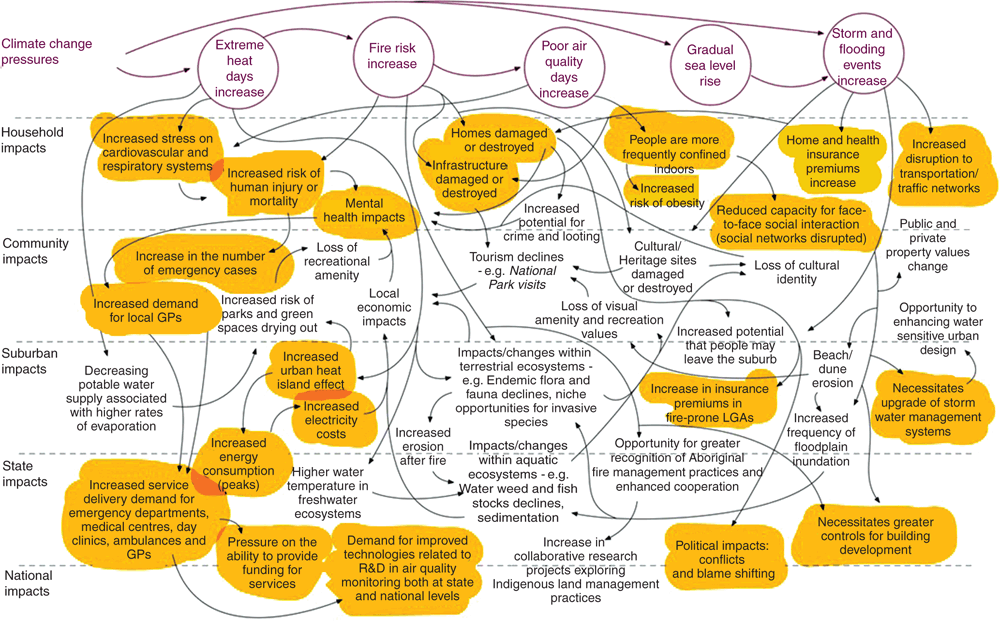
|
Climate change adaptation options for Sydney LHDs
In NSW, LHDs and Speciality Networks (e.g. Sydney Children’s Hospitals) report regularly on service agreements with the Ministry of Health and, via the Secretary of NSW Health, to the NSW Government. Ideally, climate risk assessment and adaptation by public health services would also be coordinated by the state (and national) governments to support and reinforce local implementation. Western Australia, for example, detailed in 2008 a whole-of-government adaptation strategy for the health effects of extreme events and climate change.19 The Queensland Government recently developed a human health and well-being climate change adaptation plan, and work is underway for a climate change adaptation plan for Victoria.28–30 The NSW Government supports climate change risk assessment and adaptation planning by local councils.31 However, although NSW Health offers advice to the public on extreme heat,32 there is no current government-endorsed health sector vulnerability assessment process or adaptation advice for the LHDs. The Australian Federal government only briefly describes the health risks of climate change.33
Some LHDs in NSW have environmental sustainability plans34 aimed at improving efficiency in the use of resources and reducing greenhouse gas emissions.35 However, as yet no LHDs have developed plans for the assessment of and adaptation to climate change effects. LHDs will need to consider the exposure and risk of climate change to their own substantial workforce and facilities, as well as their capacity to respond to the changing needs of the populations they serve. Health sector adaptation to climate change requires clear governance arrangements, flexibility (of location, scale and type of services across administrative boundaries), strategic allocation of resources (to adapt existing services, prioritise vulnerable groups, ensure equitable access) and robustness (resilient infrastructure, consistent services, sustainable workforce).20 It also requires a systems approach.43
The United Nations identifies climate change as a core consideration in disaster risk management.44 One existing and robust mechanism that could incorporate NSW LHDs’ climate change adaptation planning is the NSW disaster management network, which consists of a central Health Emergency Management Unit (HEMU) and LHD-based disaster management units, headed by a senior manager appointed as the Health Services Functional Area Coordinator (HSFAC). The NSW Health Services Functional Area Supporting Plan details the role of LHDs in disaster planning and response.45 The plan adopts an ‘all hazards, all incidents’ approach, and a framework for planning and response that covers four core components: prevention, preparedness, response and recovery. This network and the work that it undertakes offer a robust mechanism that should incorporate climate change adaptation preparedness. The network has already begun such work (R. Hegner, pers. comm.), and this now needs to be continued and enhanced through the development and implementation of climate and health adaptation plans.
For the purpose of discussion and to inform health service planning, we have applied the climate change vulnerabilities identified in the sections above to compile some of the factors that may be considered by Sydney metropolitan LHDs in climate change adaptation (Table 3). We have cross-referenced the predicted effects of climate change in the Sydney metropolitan area (first column) with considerations of the resulting vulnerabilities (second column) and potential LHD adaptations (third column), a model adapted from the UK Climate Impacts Program.10 The considerations are examined across the three ‘core business’ categories of: (1) ambulance, emergency and acute health care; (2) routine health care; and (3) population and preventative health services. In Table 3 we also consider the key climate change risks and vulnerabilities of the LHDs’ workforce, facilities and finances, as well some of the important transboundary issues.
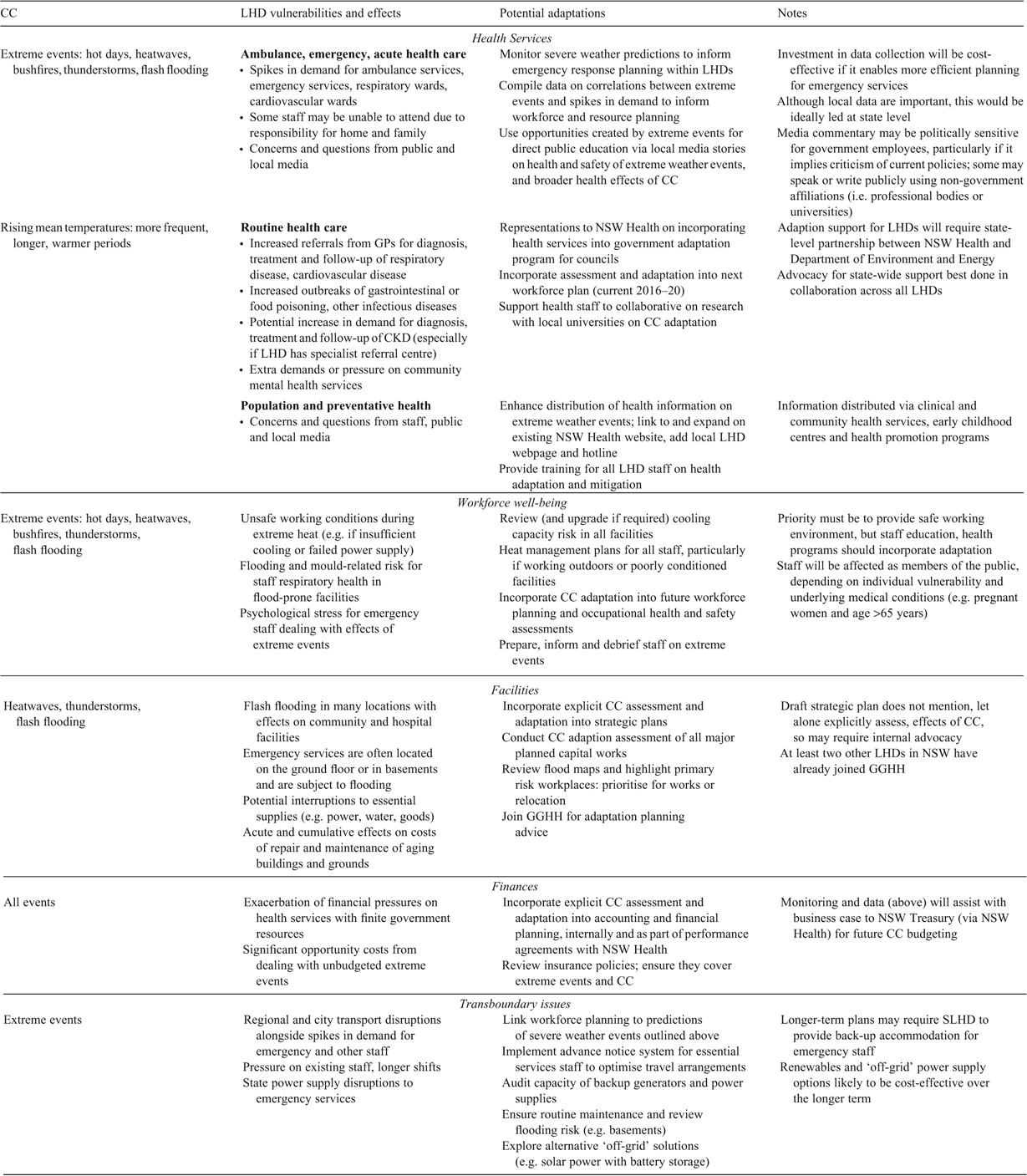
|
Conclusions
Australian health services need to increase their preparedness to respond to the unavoidable effects of climate change, including spikes in local health service demands, as well as the direct effects on a service’s capacity to respond. In this paper we illustrate how local health services can use available data and existing models of climate change impact assessment and adaptation, as applied to the example of Sydney’s LHDs. The steps in climate change adaptation planning include drawing on available climate change projections and past exposures to identify local health service risks and vulnerabilities and using systems thinking to consider current preparedness and to forecast whether and what health service adaptations will be required. Health services are mandated to prepare for and respond to health emergencies and disasters on an ongoing basis. The adverse effects of climate change should be a key factor in such planning and response. Ideally, health service adaptation should also draw on existing planning for climate change adaptation by other government departments, incorporate other existing health service quality improvement structures and processes and be integrated across local, state and national levels. We believe that timely and effective climate change adaptation planning and implementation are essential and urgent, and can offer health services longer-term financial savings, as well as a safer environment, better health care and better health.
Competing interests
The authors declare no conflicts of interest.
Acknowledgements
This research did not receive any specific funding.
References
[1] Smith K, Woodward A, Campbell-Lendrum D, Chadee D, Honda Y, Liu Q, Olwoch JM, Revich B, Sauerborn R. Human health: impacts, adaptation, and co-benefits. In: Field C, Barros V, Dokken D, Mach K, Mastrandrea M, Bilir T, Chatterjee M, Ebi KL, Estrada YO, Genova RC, Girma B, Kissel ES, Levy AN, MacCracken S, Mastrandrea PR, White LL, editors. Climate change 2014: impacts, adaptation, and vulnerability part A: global and sectoral aspects contribution of Working Group II to the fifth assessment report of the Intergovernmental Panel of Climate Change (IPCC). Cambridge, United Kingdom and New York, NY, USA: Cambridge University Press; 2014. pp. 709–54.[2] Hanna EG, McIver LJ. Climate change: a brief overview of the science and health impacts for Australia. Med J Aust 2018; 208 311–15.
| Climate change: a brief overview of the science and health impacts for Australia.Crossref | GoogleScholarGoogle Scholar |
[3] Watts N, Adger WN, Ayeb-Karlsson S, Bai Y, Byass P, Campbell-Lendrum D, Colbourn T, Cox P, Davies M, Depledge M, Depoux A, Dominguez-Salas P, Drummond P, Ekins P, Flahault A, Grace D, Graham H, Haines A, Hamilton I, Johnson A, et al The Lancet countdown: tracking progress on health and climate change. The Lancet 2016; 389 1151–64.
| The Lancet countdown: tracking progress on health and climate change.Crossref | GoogleScholarGoogle Scholar |
[4] Watts N, Amann M, Ayeb-Karlsson S, Belesova K, Bouley T, Boykoff M, Watts N, Amann M, Ayeb-Karlsson S, Belesova K, Bouley T, Boykoff M, Byass P, Cai W, Campbell-Lendrum D, Chambers J, Cox PM, Daly M, Dasandi N, Davies M, Depledge M, Depoux A, Dominguez-Salas P, Drummond P, Ekins P, Flahault A, et al The Lancet countdown on health and climate change: from 25 years of inaction to a global transformation for public health. The Lancet 2017; 391 581–630.
| The Lancet countdown on health and climate change: from 25 years of inaction to a global transformation for public health.Crossref | GoogleScholarGoogle Scholar |
[5] United Nations Framework Convention on Climate Change. Human health and adaptation: understanding climate on health and opportunities for action. 2017. Available at: https://unfccc.int/resource/docs/2017/sbsta/eng/02.pdf [verified 5 November 2018].
[6] World Health Organization (WHO). Operational framework for building climate resilient health systems. 2015. Available at: http://apps.who.int/iris/bitstream/10665/189951/1/9789241565073_eng.pdf [verified 5 November 2018].
[7] World Bank. Climate-smart healthcare. Low-carbon and resilience strategies for the health sector. Washington: World Bank Group; 2017. Available at: http://documents.worldbank.org/curated/en/322251495434571418/pdf/113572-WP-PUBLIC-FINAL-WBG-Climate-smart-Healthcare-002.pdf [verified 5 November 2018].
[8] Horsburgh N, Armstrong F, Mulvenna V. A framework for a national strategy on climate, health and well-being for Australia. Melbourne: Climate and Health Alliance; 2017. Available at: https://d3n8a8pro7vhmx.cloudfront.net/caha/pages/40/attachments/original/1498008324/CAHA_Framework_for_a_National_Strategy_on_Climate_Health_and_Well-being_v05_SCREEN_%28Full_Report%29.pdf?1498008324 [verified 5 November 2018].
[9] Commonwealth of Australia. Implications of climate change for Australia’s national security. Canberra: Foreign Affairs, Defence and Trade References Committee, The Senate; 2018.
[10] UKCIP. The UKCIP Adaption Wizard v4.0. Oxford: UKCIP. 2015. Available at: https://www.ukcip.org.uk/wizard/about-the-wizard/ [verified 5 November 2018].
[11] Marinucci GD, Luber G, Uejio CK, Saha S, Hess JJ. Building resilience against climate effects: a novel framework to facilitate climate readiness in public health agencies. Int J Environ Res Public Health 2014; 11 6433–58.
| Building resilience against climate effects: a novel framework to facilitate climate readiness in public health agencies.Crossref | GoogleScholarGoogle Scholar |
[12] Bureau of Meteorology. Special Climate Statement 61 – exceptional heat in southeast Australia in early 2017. 2017. Available at: http://www.bom.gov.au/climate/current/statements/scs61.pdf [verified 5 November 2018].
[13] Dowdy A, Abbs D, Bhend J, Chiew F, Church J, Ekström M, Kirono D, Lenton A, Lucas C, McInnes K, Moise A, Monselesan D, Mpelasoka F, Webb L, Whetton P. East Coast Cluster Report, Climate change in Australia; projections for Australia’s NRM regions. In: Ekström M, Whetton P, Gerbing C, Grose M, Webb L, Risbey J, editors. Australia: CSIRO and Bureau of Meteorology; 2015.
[14] Office of Environment and Heritage. Metropolitan Sydney: climate change snapshot. Sydney: NSW Government; 2014.
[15] Bureau of Meteorology. El Niño Southern Oscillation (ENSO). 2008. Available at: http://www.bom.gov.au/climate/about/?bookmark=enso [verified 5 November 2018].
[16] Bureau of Meteorology. East coast lows. 2008. Available from: http://www.bom.gov.au/climate/about/?bookmark=eastcoastlow [verified 5 November 2018].
[17] Lewis SC, King AD, Mitchell DM. Australia’s unprecedented future temperature extremes under Paris limits to warming. Geophys Res Lett 2017; 44 9947–56.
| Australia’s unprecedented future temperature extremes under Paris limits to warming.Crossref | GoogleScholarGoogle Scholar |
[18] Watts N, Adger WN, Agnolucci P, Blackstock J, Byass P, Cai W, Chaytor S, Colbourn T, Collins M, Cooper A, Cox PM, Depledge J, Drummond P, Ekins P, Galaz V, Grace D, Graham H, Grubb M, Haines A, Hamilton I, et al Health and climate change: policy responses to protect public health. Lancet 2015; 386 1861–914.
| Health and climate change: policy responses to protect public health.Crossref | GoogleScholarGoogle Scholar |
[19] Spickett JT, Brown H, Katscherian D. Health impacts of climate change: adaptation strategies for Western Australia. Perth: Environmental Health Directorate, Department of Health, Government of Western Australia; 2008.
[20] Blashki G, Armstrong G, Berry HL, Weaver HJ, Hanna EG, Bi P, Harley D, Spickett JT. Preparing health services for climate change in Australia. Asia Pac J Public Health 2011; 23 133S–43S.
| Preparing health services for climate change in Australia.Crossref | GoogleScholarGoogle Scholar |
[21] Navi M, Pisaniello D, Hansen A, Nitschke M. Potential health outcome and vulnerability indicators of climate change for Australia: evidence for policy development. Aust J Publ Admin 2017; 76 160–75.
| Potential health outcome and vulnerability indicators of climate change for Australia: evidence for policy development.Crossref | GoogleScholarGoogle Scholar |
[22] Navi M, Hansen A, Nitschke M, Hanson-Easey S, Pisaniello D. Developing health-related indicators of climate change: Australian stakeholder perspectives. Int J Environ Res Public Health 2017; 14 552
| Developing health-related indicators of climate change: Australian stakeholder perspectives.Crossref | GoogleScholarGoogle Scholar |
[23] Coates L, Haynes K, O’Brien J, McAneney J, de Oliveira FD. Exploring 167 years of vulnerability: an examination of extreme heat events in Australia 1844–2010. Environ Sci Policy 2014; 42 33–44.
| Exploring 167 years of vulnerability: an examination of extreme heat events in Australia 1844–2010.Crossref | GoogleScholarGoogle Scholar |
[24] Kjellstrom T, Briggs D, Freyberg C, Lemke B, Otto M, Hyatt O. Heat, human performance, and occupational health: a key issue for the assessment of global climate change impacts. Annu Rev Public Health 37: 97–112.
[25] Doctors for the Environment Australia. Heatwaves and health in Australia. Fact sheet. 2016. Available at: https://www.dea.org.au/wp-content/uploads/2017/02/DEA_Heatwaves__Health_Fact_Sheet_06.pdf [verified 5 November 2018].
[26] Dunford S, Lee C, Jacobs B, Neirinckx A. The towards a resilient Sydney project: from collective assessment to strategic frameworks. In: Burton P, Shearer H, editors. Proceedings of the State of Australian Cities Conference (SOAC 7); 9–11 December 2015; Gold Coast, Queensland, Australia. 2015. Available at: http://apo.org.au/node/63235 [verified 5 November 2018].
[27] Intergovernment Panel on Climate Change (IPCC). Climate change 2014: synthesis report. Contribution of Working Groups I, II and III to the Fifth Assessment Report of the Intergovernmental Panel on Climate Change. Geneva: IPCC; 2014.
[28] Cooke S, Armstrong F, Rissik D. Queenslanders to benefit from health plan to combat climate change impacts. Croakey 5 March 2018. Available at: https://croakey.org/queenslanders-to-benefit-from-health-plan-to-combat-climate-change-impacts/ [verified 5 November 2018].
[29] Armstrong F, Cooke S, Rissik D, Tonmoy F. Human health and wellbeing climate change adaptation plan for Queensland. Brisbane: Queensland Government; 2018.
[30] Victoria State Government. Environmental sustainability strategy 2018–2023 – draft for comment. Melbourne: Department of Health and Human Services; 2018.
[31] Office of Environment and Heritage. Understanding and adapting to climate change impacts in New South Wales. 2017. Available at: http://climatechange.environment.nsw.gov.au/ [verified 5 November 2018].
[32] NSW Health. How to stay healthy in the heat. 2016. Available at: http://www.health.nsw.gov.au/environment/beattheheat/Pages/stay-healthy-in-heat.aspx [verified 5 November 2018].
[33] Department of the Environment and Energy. Climate change impacts in Australia. 2018. Available at: http://www.environment.gov.au/climate-change/climate-science-data/climate-science/impacts [verified 29 November 2018].
[34] Sydney Local Health District (SLHD). Sustainability plan 2013–2018. Sydney: Sydney Local Health District; 2012.
[35] Charlesworth K, Stewart G, Sainsbury P. Addressing the carbon footprint of health organisations: eight lessons for implementation. Public Health Res Pract. 2018; 28 e2841830
| Addressing the carbon footprint of health organisations: eight lessons for implementation.Crossref | GoogleScholarGoogle Scholar |
[36] Loosemore M, Chand A. Hospitals feel the heat too from extreme weather and its health impacts. The Conversation 11 January 2017. Available at: https://theconversation.com/hospitals-feel-the-heat-too-from-extreme-weather-and-its-health-impacts-70997 [verified 5 November 2018].
[37] Vaneckova P, Bambrick H. Cause-specific hospital admissions on hot days in Sydney, Australia. PLoS One 2013; 8 e55459
| Cause-specific hospital admissions on hot days in Sydney, Australia.Crossref | GoogleScholarGoogle Scholar |
[38] Schaffer A, Muscatello D, Broome R, Corbett S, Smith W. Emergency department visits, ambulance calls, and mortality associated with an exceptional heat wave in Sydney, Australia, 2011: a time-series analysis. Environ Health 2012; 11 3
| Emergency department visits, ambulance calls, and mortality associated with an exceptional heat wave in Sydney, Australia, 2011: a time-series analysis.Crossref | GoogleScholarGoogle Scholar |
[39] Department of Health & Human Services. January 2009 heatwave in Victoria: an assessment of health impacts/ 2012 Available at: https://www2.health.vic.gov.au/getfile//?sc_itemid=%7B78C32CE8-A619-47A6-8ED1-1C1D34566326%7D [verified 5 November 2018].
[40] Browne R. Sydney and Hunter battered by heavy rain, thunder and lightening. The Sydney Morning Herald 27 October 2017. Available at: http://www.smh.com.au/environment/weather/sydney-battered-by-heavy-rain-thunder-and-lightning-as-storm-hit-20171026-gz982l.html [verified 5 November 2018].
[41] Han E. Health experts urge asthma and hay fever sufferers to be prepared as spring sets in. The Sydney Morning Herald 3 September 2017. Available at: http://www.smh.com.au/nsw/health-experts-urge-asthma-and-hay-fever-sufferers-to-be-prepared-as-spring-sets-in-20170901-gy9eey.html [verified 5 November 2018].
[42] Hannam P. Australia water supplies at risk from extreme weather, study finds. The Sydney Morning Herald 21 January 2014. Available at: http://www.smh.com.au/environment/climate-change/australian-water-supplies-at-risk-from-extreme-weather-study-finds-20140121-316qw.html [verified 5 November 2018].
[43] Berry HL, Waite TD, Dear KBG, Capon AG, Murray V. The case for systems thinking about climate change and mental health. Nat Clim Chang 2018; 8 282–90.
| The case for systems thinking about climate change and mental health.Crossref | GoogleScholarGoogle Scholar |
[44] United Nations (UN). Sendai framework for disaster risk reduction 2015–2030. Geneva: UN Office for Disaster Risk Reduction; 2015.
[45] Health Emergency Management Unit NSW. New South Wales health services functional area supporting plan. Sydney: NSW Health; 2014.
Appendix 1. Health effects of climate change
The current and predicted impacts of climate change on public health. Reproduced with permission from Horsburgh et al.8 Full list of supporting references available online in original document.


